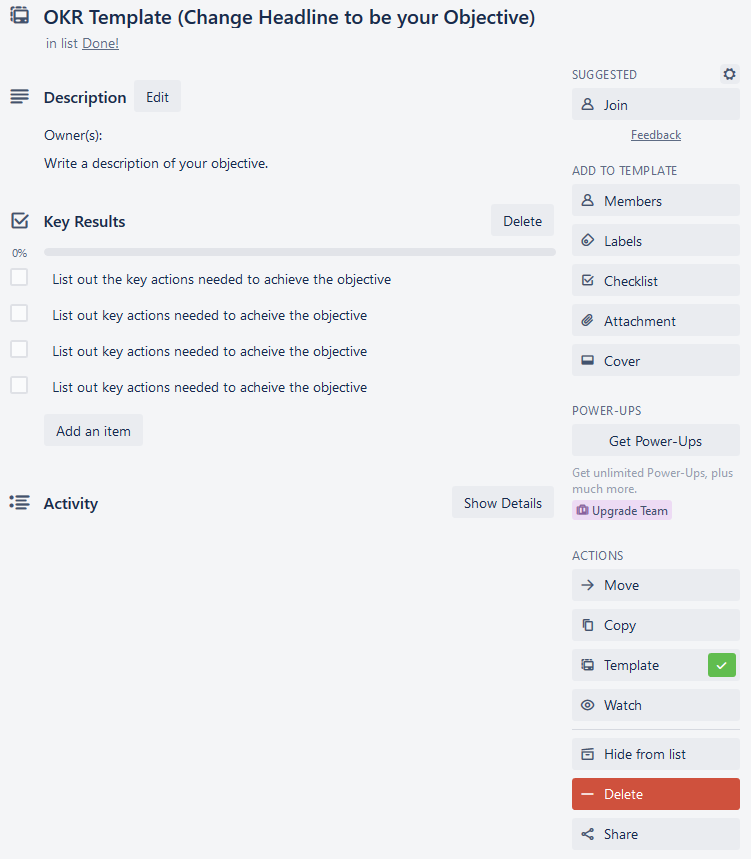Andy Grove had it right when he outlined the approach to Objectives and Key Results (OKR) management in his 1980’s book High Output Management. Setting objectives for the company, department, and individual with measurable results drives executional focus. OKR’s allow you to take your strategy from theoretical to practical, outlining the path forward to achieve your goals.
Throughout my career, objectives were soft and fluffy and only referenced one to two times per year. None of my managers pulled these objectives out on a monthly or quarterly basis to measure our progress against our goals. No one ever really dug in with me on why we were on track or off track. The objective setting that we did in the companies I worked at, rarely pushed the boundaries of what was achievable. Objectives were always high level without a definition of how they were going to be achieved. By the time a discussion took place on progress, it was too late to course-correct.
Being in a non-sales role means it is often harder and takes more time to outline objectives with key results that are measurable. Salespersons can have a clear-cut objective:
Increase annual sales by $10M
Breaking this down further, the key results could be:
- Track all sales activities in the CRM and develop weekly sales reports to show progress
- Set 75 appointments per quarter to build the pipeline to meet quarterly sales goals
- Achieve $2.5M in quarterly sales growth
Defining key results allow you to track progress against your objective. Reviewing progress against these key results on a bi-weekly or monthly basis would enable you to adjust activities if you are behind or ahead of your objective. Ultimately, it enables an employee and their supervisor to have a productive dialogue well ahead of when an objective is expected to be achieved. This ability to coach and adjust throughout the process is a critical component to developing an employee to reach their potential.
Leveraging the OKR process as a team can level up the performance of everyone. Creating team objectives and assigning key results to different team members drives buy-in and commitment across the team. The shared objectives create a shared mission.
Using the same objective above: Increase Annual Sales by $10M, we could break down key results in a slightly different way for the team:
- Each of our 5 sales regions drives $500K of incremental revenue a quarter
- Sales Region 1 and 3 set 25 appointments per quarter to build the pipeline to meet sales goals
- Sales Region 2, 4 and 5 set 50 appointments per quarter to build the pipeline to meet sales goals
- Identify 2 to 5 national clients that regions will partner on the sales pitch
Once team objectives are set, you can use the same process of checking-in on the progress every month. Reinforcing that the objective is best met with the team collaborating and assisting each other often results in the teams’ performance increasing as a whole. If a team member is behind or struggling, others will be motivated to step in and coach or assist so the team meets their objective.
The examples above are easily outlined, due to the sales orientation of the objective. It is straightforward to track sales. Let’s look at a non-sales example. Using the trend of introducing Agile as a method within a business, let us create the following objective:
Implement the Agile Methodology within our Organization
The Key Results could look like the following:
- Introduce Agile Training that will cover the process, roles and responsibilities, and tools
- Hire an Agile coach to provide day to day support for teams
- Select and implement a tool to capture user stories, organize work by project and individual team
- Determine metrics to capture how time to market will be measured
- Develop reports to show time to market from an idea to production to show if the objective is achieved
If the objective listed above is a team objective, you may choose to turn one of the key results into an individual’s team members OKR. For example, the objective could be:
Hire Agile Coach(es) to provide day to day support for teams by March
- Identify criteria to hire an Agile Coach (Culture Fit, Price, Experience)
- Identify 2–3 coaches / Agile firms to interview
- Negotiate contract for Agile Coach(es)
- Onboard and introduce Agile Coach(es)
As you see how OKRs can be broken down and assigned out, you may be asking at what level do you stop breaking them down. This is a judgment call, but as they say “Inspect what you expect”. If you believe that you need increased visibility to how an objective will be met then continue to break the OKRs down.
To create clear objectives and key results, it will take dedicated focus and time. You may have to think about your business and how you go about your work differently. Getting comfortable with details and holding yourself and your team accountable for them is a cultural and behavioral shift. You can start small by setting only 2–3 OKRs for yourself to start or you can choose to engage your team immediately and set 2–3 OKRs for the team. Either way, starting is the hardest part, but after a few months of reviewing the progress of the key results for each objective, it will start to feel more familiar.
I have seen teams come together and rally around their OKRs in part because everyone knows what is expected of them and the team. This clarity of purpose and consistent checking on progress creates the right environment to be able to drive results and make adjustments as necessary.
I have used Trello as a way to capture, share and track my OKRs. In Trello you can set up a team board and an OKR template. See an example below of the template:

For more information on OKRs here are a few links you might find of use:


